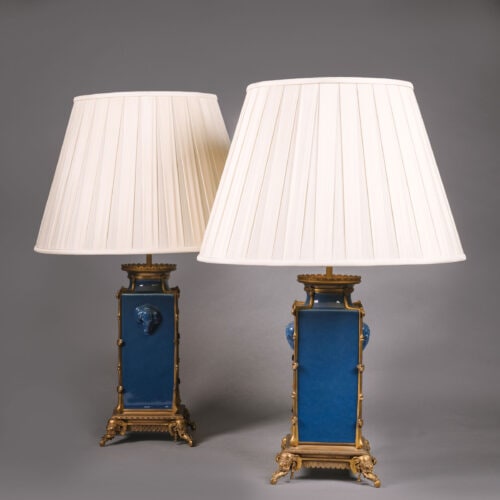Escalier De Cristal
An Important Pair of Empire Gilt-Bronze And Cut-Crystal Six-Light Candelabra
£65,000
This exceptional pair of candelabra can almost certainly be attributed to the workshops of l' Escalier de Cristal de Paris. They relate in particular to...
Dimensions
Height: 97 cm (39 in)Width: 31 cm (13 in)
Depth: 31 cm (13 in)
Description
This exceptional pair of candelabra can almost certainly be attributed to the workshops of l’ Escalier de Cristal de Paris. They relate in particular to a dressing table and chair, now in the collection of the Louvre, which formed part of a toilette suite that was exhibited by L’Escalier de Cristal at the 1819 Paris exhibition of the Produits de l’industrie. The present candelabra may very likely have been made as part of this suite.
The toilette suite was purchased following the exhibition by one of Escalier de Cristal’s most famous patrons, the Duchess de Berry, Louis XVIII’s niece, and was subsequently installed in her country residence, the Château de Rosny-sur-Seine.
These candelabra display identical decorative motifs to those employed in the Louvre dressing table and chair. The crystal cornucopias, formed with a seemingly impossible complexity of curvature, are identical to the legs of the dressing table, while the gilt bronze dolphins and plinths constructed from crystal plaques are repeated on both the dressing table and the accompanying chair. The candelabra and the toilette suite are also of identical construction, with cut crystal plaques and sleeves assembled on an iron structure. The brilliance of the design is that the iron armature is almost completely dissimulated by the cut crystal elements, maintained by gilded and engraved bronze rings and collars of the highest quality.
The model for the toilette suite has been attributed to Nicholas-Henri Jacob, one of Jacques-Louis David’s former students. L’Escalier de Cristal are known to have produced a number of items based on models by Jacob, including a well documented series of cut crystal and gilt bronze decorative objects, which were supplied to Queen Marie Louise of Parma in Spain.
Date
Circa 1819
Origin
France
Medium
Satinwood
L’Escalier de Cristal (1802-1923) was established by Marie Jeanne Rosalie Désarnaud-Charpentier, the daughter of a goldsmith from Châlons-sur-Marne, when she opened her renowned boutique in the Galerie de Valois of the Palais Royal in 1802. There she specialised in objects of great technical and aesthetic innovation, many composed entirely of crystal and gold plated bronze. What the previous century had done incorporating porcelain into objects and furnishings, Mme Désarnaud-Charpentier did with crystal in the nineteenth. Sadly very few of these crystal furnishings survive with us today.
Mme Désarnaud-Charpentier’s fame was secured by the success of her innovative suite of furniture at the 1819 exhibition of the produits de l’industrie , where she was awarded a gold medal. This toilette suite was purchased following the exhibition by one of Escalier de Cristal’s most famous patrons, the Duchess de Berry, Louis XVIII’s niece, and was subsequently installed in her country residence, the Château de Rosny-sur-Seine.
This exhibition, followed on from her success at the Paris 1801 exhibition. The competitive character of the exhibitions led many manufactories and maisons de luxe to create objects of increasing daring and originality; despite this for the judges and visitors the technical innovation of Escalier de Cristal’s creations would have been a revelation.
In 1840, Pierre-Isidore Lahoche acquired L’Escalier de Cristal; joined later by his cousin Emile-Augustin Pannier, the company would become in 1867 Lahoche, Pannier et Cie. At the end of 1872, Pierre-Isidore Lahoche retired from business leaving his son-in-law in charge of the company. The boutique moved to the centre of Paris, at the corner of rues Auber and Scribe, a few steps away from Opera Garnier.
By 1885 the company was known simply as Pannier et cie, managed by Georges and Henri Pannier, sons of Emile. Henri Pannier was the art director whereas Georges took care of the finances. In the last decades of the 19th century the company widened its repertoire to include exceptional furniture in Louis XV and Louis XVI revival styles and ground breaking works by designer-ornamentists such as Edouard Lièvre. In the tradition of the 17th and 18th century marchand-merciers, they would collaborate with the finest bronziers, ebenistes, lacquers and painters of the day creating objects of unparalleled luxury and embracing sophisticated modernist styles such as extreme oriental and japonisant.
The company won multiple awards and medals at national and international exhibitions, including bronze medals at the Universal Exhibitions in London in 1862, and in Paris in 1867 and 1878. They were awarded a gold medal at the 1900 Paris Exposition Universelle.
The firm finally closed in 1923.
The large number of objects that remain today in the possession of European Royal households, that were made by Escalier de Cristal, attests to the success and reputation the company achieved. Pieces also remain in the collections of the Louvre and Musée D’Orsay.
Bibliography:
De Commines, Laurent & Gizard, Eric. Un √Çge D’or Des Arts Décoratifs 1814-1848, Réunion des Musées Nationaux, (Paris), 1991.










 Print
Print


